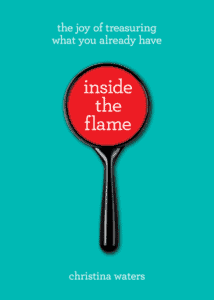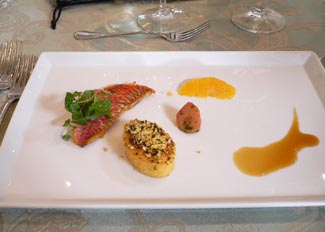
by Christina Waters | Feb 28, 2007 | Food, Home |
The Masters of Food & Wine, which has brought the most celebrated chefs and winemakers in the country together each February for a week of lunches, dinners, tastings and demos— is folding its designer tents after 21 years. At least it will no longer be held in the atmospheric Carmel highlands, according to current organizers.
Since I had attended the very first Masters, I decided to find closure in the form of lunch last week — prepared by Michel Richard (Citronelle, Washington DC), David Kinch (Manresa, Los Gatos), Cal Stamenov (Marinus, Carmel Valley) and Herve Fucho (Four Seasons, Punta Mita). 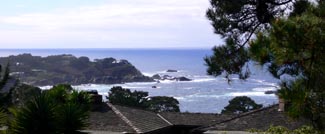 Sprawling out into the entire main lobby of the Highlands Inn (I know you know what it looks like but I couldn’t resist reminding you), a dozen round tables — each seating ten — were set with a crystal acreage of stemware. An opening salvo of passed amuses included Veuve Clicquot gelée topped with kiwi and cucumer, and a sensational escargot tart — all by Keiko Takahashi of Mill Valley’s El Paseo. The lunch moved into conceptual territory thanks to fabled French chef Michel Richard. We were served what appeared to be large bowls with a central mound of caviar. However, the “caviar†turned out to be Israeli cous cous bathed in black squid ink. This mildly flavored conceit covered a bed of “scrambled†scallops. The world’s thinnest, crispest potato chip topped it off. Next came Fucho’s course — very beautifully arranged – of seared
Sprawling out into the entire main lobby of the Highlands Inn (I know you know what it looks like but I couldn’t resist reminding you), a dozen round tables — each seating ten — were set with a crystal acreage of stemware. An opening salvo of passed amuses included Veuve Clicquot gelée topped with kiwi and cucumer, and a sensational escargot tart — all by Keiko Takahashi of Mill Valley’s El Paseo. The lunch moved into conceptual territory thanks to fabled French chef Michel Richard. We were served what appeared to be large bowls with a central mound of caviar. However, the “caviar†turned out to be Israeli cous cous bathed in black squid ink. This mildly flavored conceit covered a bed of “scrambled†scallops. The world’s thinnest, crispest potato chip topped it off. Next came Fucho’s course — very beautifully arranged – of seared rouget and tiny islands of polenta, glazed pink beets, and orange sauce with a plume of lemon balm. Nice, but not sensational.
rouget and tiny islands of polenta, glazed pink beets, and orange sauce with a plume of lemon balm. Nice, but not sensational.
The main course was David Kinch’s succulent slice of alabaster poularde (French hen), 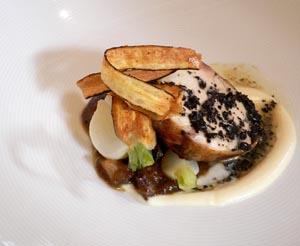 astride a pretty array of thumbnail white turnips, onions and tea-poached prunes. Dusted with truffles! Paired with a stylish pinot noir from Bergstrom Winery in the Willamette Valley of Oregon, it was a knock-out dish. Incidentally, Kinch has formed an alliance with Santa Cruz Mountains grower Cynthia Sandberg (Love Apple Farm), who now grows all the organic produce for Manresa’s kitchen.
astride a pretty array of thumbnail white turnips, onions and tea-poached prunes. Dusted with truffles! Paired with a stylish pinot noir from Bergstrom Winery in the Willamette Valley of Oregon, it was a knock-out dish. Incidentally, Kinch has formed an alliance with Santa Cruz Mountains grower Cynthia Sandberg (Love Apple Farm), who now grows all the organic produce for Manresa’s kitchen.
Also a knock-out was the pan-seared slice of crimson Wagyu beef rib-eye (see below), paired with a few choice infant veggies and black truffle vinaigrette. The beef, delicately, and intensely marbled and dusted with sea salt, redefined the whole point of red meat. (Check the industry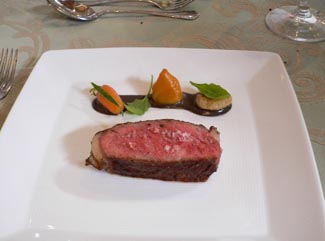 standard, Lobel’s beef website for mouth-watering information. Unless you’re a vegetarian.)
standard, Lobel’s beef website for mouth-watering information. Unless you’re a vegetarian.)
By this point in the meal, there was a lot of heavy breathing going on in the room. Marisa Churchill’s (Top Chef) vanilla panna cotta — dusted with grated vanilla bean and accompanied by diced mango and basil, an opulent fresh mango sauce and a pistachio Florentine was so good it brought tears to my eyes. Illy Caffé finished off a meal worthy of the Masters. Next year, the ambitious food and wine gathering is rumored to be landing in Argentina! Can you say “gaucho�
by Christina Waters | Feb 27, 2007 | Food, Home |
Hopefully there will be more, once co-owners Keet Beck-Brattin and Damani Thomas, settle on a new location. The old brick bistro was the place of many memories, so Jack and I made the most of our “farewell Oswald” dinner last week. A gorgeous Cabernet Sauvignon from Chile — Los Vascos Reserve 2004 — made the perfect partner for starters of buttery venison tartare and crisp local calamari with Meyer lemon aioli. A braised chicken curry entree tasted like subtle comfort food, but my pan-roasted pork tenderloin, surrounded with sensuous tea-poached prunes, sauteed cabbage and a cushion of spatzle was the winner. Service at Oswald has always set the standard and I can only hope for a swift new incarnation of this local treasure.
I speak for many Oswald fans when I say “thanks for the memories!â€
by Christina Waters | Feb 27, 2007 | Food, Home |
Prince Charles wants to get rid of all the McDonald’s franchises in England. Why? Because of the obesity epidemic in the Old Country. Finally, somebody’s getting the hint. If you insist on super-sizing fast food portions, you end up super-sizing fast food patrons.
This is a no-brainer. But the ugly underbelly of it all is a moral issue — the issue of personal responsibility. Fast food businesses, which are definitely culprits in the expansion of the US, and the UK, and just about every other capitalist society in the world, these businesses are guilty of pushing fat, salt and sugar on a public that’s just trying to get full on not much money.
But surely the public is to blame as well. No one is holding a gun to your head and forcing you to eat those ridiculously large portions of fries, burgers and sodas. Restaurants claim that “the public” demands big portions — how else will they know they’re having a great dining experience? (Well, actually, how about wonderful flavors, attractive presentation, fresh ingredients? Those might be involved in a great dining experience. . . .)
Which came first? The huge portions, or the demand for big bang for the buck?
Probably the demand came first. Quantity – that’s what the restaurant-going public seems to demand. Did it never occur to Mr. and Mrs. Front Porch to limit quantity and go for quality instead? Think about it. You could eat well, without over-eating.
Food is often compared to sex. So I ask you: Is lots of mediocre sex really more desireable than less frequent encounters of really great, well,. . . you get my drift.
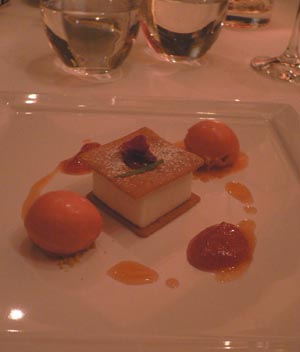
by Christina Waters | Feb 23, 2007 | Food, Home |
In a word, “yes.” But I already knew that, having been lucky enough to dine in the original Paris version of Le Bernardin, as well as the Manhattan one twice before. Perhaps only Jules Verne has done more for seafood than Le Bernardin chef Eric Ripert. But then the Michelin people also know that. Three stars.
My dining partner was a Le Bernardin devotée and longtime Manhattan artist and she was as thrilled with the meal as I was. Armed with a glass of Puligny-Montrachet more costly than most bottles of wine I have in my house, I plunged into a beautiful world of flavors.
It began with an amuse fit for the angels. In a shot glass, lavish morsels of Maine lobster, sweet and moist, sat suspended in a warm lobster foam. My appetizer of yellow fin, pounded thin enough to read through, was layered over a frosting of foie gras, over a paper-thin slice of baguette toast. Each bite moved down through the sparkling tuna, the creamy foie gras and into the crisp toast. Sensational.
Next came a course of warm peeky-toe crab, (more…)
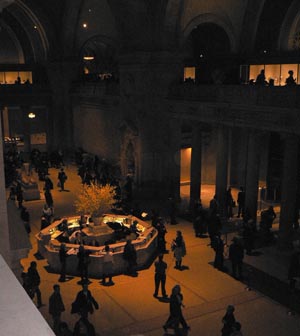
by Christina Waters | Feb 23, 2007 | Food, Home |
Manhattan – where the national color is black and the diversity is abundant. You can tell the tourists immediately – they are not wearing black, and they aren’t wearing one of those big, cashmere mufflers that are required in the City. In an effort to stretch my culinary dollars I lived a schizophrenic food life last week, ranging from lunches of trail mix to 3-star Michelin dinners. In between, I walked as far as the snowy, slushy streets would allow and inhaled great architecture and even greater artworks. In a nutshell:
The Metropolitan Museum of Art – still the greatest single temple of art in the country – where I drooled shamelessly over the mind-melting couture collection of Nan Kempner, whose Yves St. Laurent-clad figure adorned the pages of
Vogue Magazine regularly during my girlhood. . . . I visited my personal favorites in the Rembrandt room, and discovered surprising new passions in the “Glitter & Doom” show. A major revelation – Otto Dix, Christian Schad, and Max Beckmann exposing the craven underbelly of German cafe culture between the wars. . . .

The Met also offered my wonderful final meal of the trip. I went on Friday evening — the Met is open until 9pm on Fri & Sat – and found a string quartet filling the graceful lobby rotunda with music. At a table along the upper mezzanine balcony, I enjoyed a trio of cheeses, with crostini, grapes and figs – plus a McLaran Vale Shiraz 2Up, 2005, filled with berries and earth-tones. Incomparable ambience, nice food, for $21 – including bubbling water. When you go to New York, by all means visit the Met on a weekend evening. Lots of action, and fewer crowds.
It was, other than the trail mix, the cheapest meal I had in the City.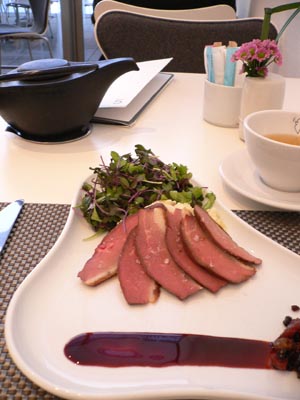
The Modern: MOMA, despite its hefty $20 admission, delivered the goods. The Jackson Pollack room alone is worth the twenty bucks. But then so were a few choice Diebenkorns and DeKoonings. I always visit the Terrace Cafe at MOMA, on the 5th floor. Seriously beautiful food, served in an austere white room (really smart, since your eyes need a break after feasting on all that modern art), and for reasonable prices.
My lunch consisted of sliced duck, fanned out on a salad of Yukon gold potatoes bathed in aged goat sheese and horse radish ($15). A fluff of infant cabbage spouts sat at the top of the plate. A slick of Port glaze went nicely with the duck — but then, they knew that — and a little mound of fruit that had been simmered in the Port sat on the side. Raisins, cranberries, sultanas, oh my. Conceptually perfect. Add a pot of herbal tea, absolutely right for the cold weather (the high that day was 24 degrees!), and you have heaven for twentysomething dollars.
Another night I dined at Lupa Osteria Romana — another one of Mario Batali’s loud, exciting, to-die-for food palaces in Greenwich Village. (more…)
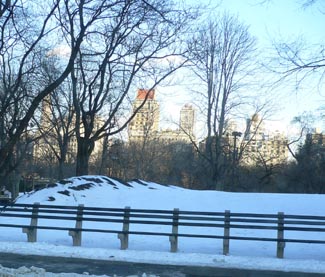
by Christina Waters | Feb 23, 2007 | Food, Home, Travel |
 Yes, it was snowy in Manhattan last week! Beautiful, crisp and COLD. But that didn’t stop me from devouring all the food and art the law would allow.
Yes, it was snowy in Manhattan last week! Beautiful, crisp and COLD. But that didn’t stop me from devouring all the food and art the law would allow.
Central Park, as you can see (that’s the Dakota, where John Lennon lived, in the background) looked gorgeous. I drove through it on my way to breakfast at the Neue Galerie‘s decadent Cafe Sabarsky. Pastries lined up like it was Vienna 1923 all over again.
The Neue Galerie, art lovers will recall, is the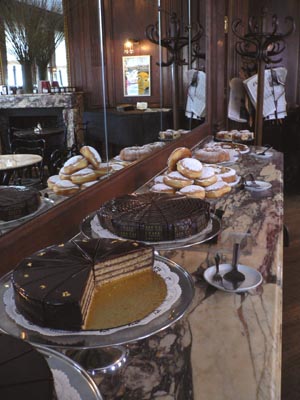 jewelbox mansion on 5th Avenue (at 86th) that Ronald Lauder (Estee’s son) transformed into a home for Austrian and German artwork. The current exhibition includes four rooms of furniture, textiles, wallpaper – the works – designed by the Wiener Werkstatt’s Josef Hoffman (the Viennese equivalent of Charles Rennie MacIntosh). (more…)
jewelbox mansion on 5th Avenue (at 86th) that Ronald Lauder (Estee’s son) transformed into a home for Austrian and German artwork. The current exhibition includes four rooms of furniture, textiles, wallpaper – the works – designed by the Wiener Werkstatt’s Josef Hoffman (the Viennese equivalent of Charles Rennie MacIntosh). (more…)

 Sprawling out into the entire main lobby of the Highlands Inn (I know you know what it looks like but I couldn’t resist reminding you), a dozen round tables — each seating ten — were set with a crystal acreage of stemware. An opening salvo of passed amuses included Veuve Clicquot gelée topped with kiwi and cucumer, and a sensational escargot tart — all by Keiko Takahashi of Mill Valley’s El Paseo. The lunch moved into conceptual territory thanks to fabled French chef Michel Richard. We were served what appeared to be large bowls with a central mound of caviar. However, the “caviar†turned out to be Israeli cous cous bathed in black squid ink. This mildly flavored conceit covered a bed of “scrambled†scallops. The world’s thinnest, crispest potato chip topped it off. Next came Fucho’s course — very beautifully arranged – of seared
Sprawling out into the entire main lobby of the Highlands Inn (I know you know what it looks like but I couldn’t resist reminding you), a dozen round tables — each seating ten — were set with a crystal acreage of stemware. An opening salvo of passed amuses included Veuve Clicquot gelée topped with kiwi and cucumer, and a sensational escargot tart — all by Keiko Takahashi of Mill Valley’s El Paseo. The lunch moved into conceptual territory thanks to fabled French chef Michel Richard. We were served what appeared to be large bowls with a central mound of caviar. However, the “caviar†turned out to be Israeli cous cous bathed in black squid ink. This mildly flavored conceit covered a bed of “scrambled†scallops. The world’s thinnest, crispest potato chip topped it off. Next came Fucho’s course — very beautifully arranged – of seared rouget and tiny islands of polenta, glazed pink beets, and orange sauce with a plume of lemon balm. Nice, but not sensational.
rouget and tiny islands of polenta, glazed pink beets, and orange sauce with a plume of lemon balm. Nice, but not sensational. astride a pretty array of thumbnail white turnips, onions and tea-poached prunes. Dusted with truffles! Paired with a stylish pinot noir from Bergstrom Winery in the Willamette Valley of Oregon, it was a knock-out dish. Incidentally, Kinch has formed an alliance with Santa Cruz Mountains grower Cynthia Sandberg (Love Apple Farm), who now grows all the organic produce for Manresa’s kitchen.
astride a pretty array of thumbnail white turnips, onions and tea-poached prunes. Dusted with truffles! Paired with a stylish pinot noir from Bergstrom Winery in the Willamette Valley of Oregon, it was a knock-out dish. Incidentally, Kinch has formed an alliance with Santa Cruz Mountains grower Cynthia Sandberg (Love Apple Farm), who now grows all the organic produce for Manresa’s kitchen. standard, Lobel’s beef website for mouth-watering information. Unless you’re a vegetarian.)
standard, Lobel’s beef website for mouth-watering information. Unless you’re a vegetarian.)




 jewelbox mansion on 5th Avenue (at 86th) that Ronald Lauder (Estee’s son) transformed into a home for Austrian and German artwork. The current exhibition includes four rooms of furniture, textiles, wallpaper – the works – designed by the Wiener Werkstatt’s Josef Hoffman (the Viennese equivalent of Charles Rennie MacIntosh).
jewelbox mansion on 5th Avenue (at 86th) that Ronald Lauder (Estee’s son) transformed into a home for Austrian and German artwork. The current exhibition includes four rooms of furniture, textiles, wallpaper – the works – designed by the Wiener Werkstatt’s Josef Hoffman (the Viennese equivalent of Charles Rennie MacIntosh). 